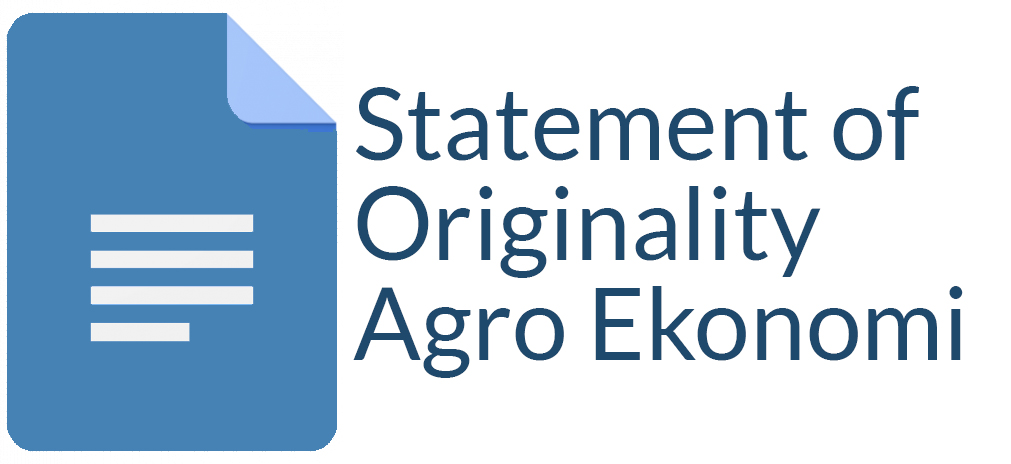Farmers' Willingness to Pay for Bio-slurry Fertilizer in Central Java
Malinda Aptika Rachmah(1*), Dwidjono Hadi Darwanto(2), Jangkung Handoyo Mulyo(3)
(1) Faculty of Agriculture, Universitas Gadjah Mada
(2) Faculty of Agriculture, Universitas Gadjah Mada
(3) Faculty of Agriculture, Universitas Gadjah Mada
(*) Corresponding Author
Abstract
Bio-slurry is the residual product of biogas processing waste through the decomposition process without oxygen (anaerobic). Bio-slurry can be used as organic fertilizer for agricultural land. This study aims to: 1) assess the value of willingness to pay (WTP) for bio-slurry fertilizer, 2) find factors affecting farmer’s willingness to pay (WTP) of bio-slurry fertilizer. The research was carried out from January to February 2020 in Central Java. Determination of the location is purposive based on the farmers in Magelang and Demak Regency that have utilized biogas waste to be organic fertilizer and had been commercialized. Primary data were obtained from 80 farmers using purposive sampling, with the aid of questionnaire. Data analysis using contingent value method (CVM) to evaluate the farmer’s willingness to pay and logistic regression to analyze its determinant factors. The result showed that farmer’s willingness to pay (WTP) rate of bio-slurry fertilizer was IDR. 937,5/kg, which was above the market price. The determinant factors are farm income, education, price, and experience using organic fertilizer positively related to farmers’ willingness to pay bio-slurry fertilizer whereas land area negatively related to farmers’ willingness to pay bio-slurry fertilizer. The value of willingness to pay show the opportunity for bio-slurry fertilizer to survive in market by taking into account continuity of production and quality.
Keywords
Full Text:
XMLReferences
Adityawarman, A. C., Salundik & Lucia. (2015). Pengolahan Limbah Ternak Sapi Secara Sederhana di Desa Pattalassang Kabupaten Sinjai Sulawesi Selatan. Jurnal Ilmu Produksi dan Teknologi Hasil Peternakan, 3(3), 171–177. https://doi.org/10.29244/jipthp.3.3.171-177
Ambarita, J. P., & Kartika, I. N. (2015). Pengaruh Luas Lahan, Penggunaan Pestisida, Tenaga Kerja, Pupuk Terhadap Produksi Kopi di Kecamatan Pekutatan Kabupaten Jembrana. E-Jurnal Ekonomi Pembangunan Universitas Udayana, 4(7), 776–793. Retrieved from https://ojs.unud.ac.id/index.php/eep/article/view/12618
Amirnejad, H., & Tonakbar, P. (2015). The Willingness to Pay for Organic Milk by Consumers in Tehran. Journal of Agricultural Science and Technology, 17, 1685–1694. Retrieved from URL: http://journals.modares.ac.ir/article-23-1063-en.html
Cheng, L., Yin, C., & Chien, H. (2015). Demand for milk quantity and safety in urban China: Evidence from Beijing and Harbin. Australian Journal of Agricultural and Resource Economics, 59(2), 275–287. https://doi.org/10.1111/1467-8489.12065
Danso, G. K., Otoo, M., Ekere, W., Ddungu, S., & Madurangi, G. (2017). Market feasibility of faecal sludge and municipal solid waste-based compost as measured by farmers’ willingness-to-pay for product attributes: Evidence from Kampala, Uganda. Resources, 6(3), 1–17. https://doi.org/10.3390/resources6030031
Etim, N.-A., & Benson, D. (2016). Willingness to Pay for Organic Fertilizer by Resource Poor Vegetable Farmers in the Humid Tropic. Journal of Agriculture and Ecology Research International, 6(2), 1–11. https://doi.org/10.9734/jaeri/2016/20230
Fauzi, A. (2010). Ekonomi Sumber Daya Alam dan Lingkungan: Teori dan Aplikasi. Jakarta: PT. Gramedia Pustaka Utama.
Insam, H., Gómez-Brandón, M., & Ascher, J. (2015). Manure-based biogas fermentation residues - Friend or foe of soil fertility? Soil Biology and Biochemistry, 84, 1–14. https://doi.org/10.1016/j.soilbio.2015.02.006
Hosmer, W. D., Lemeshow, S., Sturdivant, X. R. 2013. Applied Logistik Regression. Third Edition. New Jersey: Published by John Wiley & Sons,Inc. Hoboken.
Karisyawati, N. D., Suryantini, A., & Utami, A. W. (2019). Estimation of Consumers’ Willingness to Pay for Cavendish Banana Using Contingent Valuation Method in Special Province Yogyakarta. Agro Ekonomi, 30(2), 167–181. https://doi.org/10.22146/ae.50002
Kuwornu, J. K. M., Narh Jnr, A. B., Egyir, I. S., Onumah, E. E., & Gebrezgabher, S. (2017). Willingness to Pay for Excreta Pellet Fertilizer: Empirical evidence from Ghana. Acta Agriculturae Slovenica, 109(2), 165–173. https://doi.org/10.14720/aas.2017.109.2.14
Manja, L. P., Chirwa, G. C., & Kambewa, P. (2015). Determinants of Farmers’Willingness to pay for Subsidised Farm Inputs in Malawi. International Journal of Social Sciences and Humanity Studies, 7(1), 16–35. Retrieved from https://www.researchgate.net/publication/309681776
Massah, J., &Azadegan, B. (2016). Effect of Chemical Fertilizers on Soil Compaction and Degradation. AMA, Agricultural Mechanization in Asia, Africa and Latin America, 47(1), 44–50. Retrieved from https://www.researchgate.net/publication/303568416
McFadden, J. R., & Huffman, W. E. (2017). Willingness to Pay for Natural, Organic, and Conventional Foods: The Effects of Information and Meaningful Labels. Food Policy, 68, 214–232. https://doi.org/10.1016/j.foodpol.2017.02.007
Okon, U. E., Nkeme, K. K., Essien, U. A., Solomon, E. U., & Solomon, U. U. (2018). Urban Farmers’ Willingness to Pay and Utilize Urban Waste for Agriculture in Akwa Ibom State , Nigeria.American Journal of Environmental Protection, 6(2), 50–53. https://doi.org/10.12691/env-6-2-4
Oti Agyekum, E., Ohene-Yankyera, K., Keraita, B., Cudjoe Fialor, S., & Abaidoo, R. C. (2014). Willingness to Pay for Faecal Compost by Farmers in Southern Ghana. Journal of Economics and Sustainable Development Www.iiste.org ISSN, 5(2), 18–25. www.iiste.org
Savci, S. (2012). An Agricultural Pollutant: Chemical Fertilizer. International Journal of Environmental Science and Development, 3(1), 73–80. https://doi.org/10.7763/ijesd.2012.v3.191
Sugiyono. (2015). Metode Penelitian Kuantitatif, Kualitatif dan R&D. Bandung: Alfabeta.
Tim Biru dan Yayasan Rumah Energi. (2016). Pedoman, Pengelolaan dan Pemanfaatan Bio-Slurry. Jakarta: Tim Biogas Rumah (BIRU) dan Yayasan Rumah Energi (YRE).
Velčovská, Š., & Del Chiappa, G. (2015). The Food Quality Labels: Awareness and Willingness to Pay in The Context of The Czech Republic. Acta Universitatis Agriculturae et Silviculturae Mendelianae Brunensis, 63(2), 647–658. https://doi.org/10.11118/actaun201563020647
Zhou, Y., Zhou, Q., Gan, S., & Wang, L. (2018). Factors Affecting Farmers’ Willingness to Pay for Adopting Vegetable Residue Compost in North China. Acta Ecologica Sinica, 38(6),401–411. https://doi.org/10.1016/j.chnaes.2018.04.001
Article Metrics
Refbacks
- There are currently no refbacks.
Copyright (c) 2018 Agro Ekonomi

This work is licensed under a Creative Commons Attribution-ShareAlike 4.0 International License.
View My Stats











